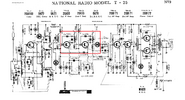Willen
Well-Known Member
Hi,
I have an old radio from National Panasonic, almost the same as the attached schematic. Mistakenly IFT of the radio are wrongly adjusted. I searched a few articles and most of them suggest making an AM-modulated 455KHz frequency generator and aligning the IFT to get a modulated AM tone louder. Currently, I aligned the IFT just tuning a station and, with louder audio output. Is it a satisfactory method or do I need a 455KHz AM-modulated frequency generator?
Another, If I tested the collector pin of the IFT transistor with an oscilloscope, can I see the 455KHz +/- waveform? (I don't have an oscilloscope but I can manage to test with help.) My 20MHz multimeter showing nothing.
I have an old radio from National Panasonic, almost the same as the attached schematic. Mistakenly IFT of the radio are wrongly adjusted. I searched a few articles and most of them suggest making an AM-modulated 455KHz frequency generator and aligning the IFT to get a modulated AM tone louder. Currently, I aligned the IFT just tuning a station and, with louder audio output. Is it a satisfactory method or do I need a 455KHz AM-modulated frequency generator?
Another, If I tested the collector pin of the IFT transistor with an oscilloscope, can I see the 455KHz +/- waveform? (I don't have an oscilloscope but I can manage to test with help.) My 20MHz multimeter showing nothing.
Attachments
Last edited:


